Mughal or Moghul may refer to:

Gujarat is a state along the western coast of India. Its coastline of about 1,600 km (990 mi) is the longest in the country, most of which lies on the Kathiawar peninsula. Gujarat is the fifth-largest Indian state by area, covering some 196,024 km2 (75,685 sq mi); and the ninth-most populous state, with a population of 60.4 million. It is bordered by Rajasthan to the northeast, Dadra and Nagar Haveli and Daman and Diu to the south, Maharashtra to the southeast, Madhya Pradesh to the east, and the Arabian Sea and the Pakistani province of Sindh to the west. Gujarat's capital city is Gandhinagar, while its largest city is Ahmedabad. The Gujaratis are indigenous to the state and their language, Gujarati, is the state's official language.
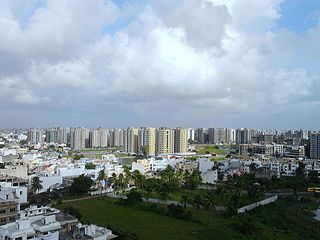
Surat is a city in the western Indian state of Gujarat. The word Surat literally means face in Gujarati and Hindi. Located on the banks of the river Tapti near its confluence with the Arabian Sea, it used to be a large seaport. It is now the commercial and economic center in South Gujarat, and one of the largest urban areas of western India. It has well-established diamond and textile industry, and is a major supply centre for apparels and accessories. About 90% of the world's diamonds are cut and polished in Surat. It is the second largest city in Gujarat after Ahmedabad and the eighth largest city by population and ninth largest urban agglomeration in India. It is the administrative capital of the Surat district. In recent years, Surat has been noted for achieving a Guinness World Record for the largest gathering for a yoga session at one place where 153,000 people joined the event on International Yoga Day.

The Grand Trunk Road is one of Asia's oldest and longest major roads. For at least 2,500 years it has linked Central Asia to the Indian subcontinent. It runs roughly 2,400 km (1,491 mi) from Teknaf, Bangladesh on the border with Myanmar west to Kabul, Afghanistan, passing through Chittagong and Dhaka in Bangladesh, Kolkata, Kanpur, Delhi, Amritsar in India, and Lahore, Gujrat, Rawalpindi, and Peshawar in Pakistan.
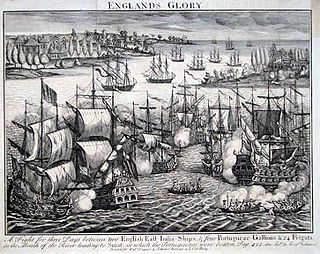
The naval Battle of Swally, also known as Battle of Suvali, took place on 29–30 November 1612 off the coast of Suvali a village near the Surat city and was a victory for four English East India Company galleons over four Portuguese galleons and 26 barks.
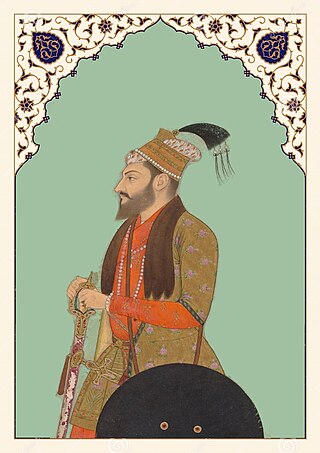
Mirza Muhammad Murad Bakhsh (9 October 1624 – 14 December 1661) was a Mughal prince and the youngest surviving son of Mughal Emperor Shah Jahan and Empress Mumtaz Mahal. He was the Subahdar of Balkh, till he was replaced by his elder brother Aurangzeb in the year 1647.

Indo-Islamic architecture is the architecture of the Indian subcontinent produced by and for Islamic patrons and purposes. Despite an initial Arab presence in Sindh, the development of Indo-Islamic architecture began in earnest with the establishment of Delhi as the capital of the Ghurid dynasty in 1193. Succeeding the Ghurids was the Delhi Sultanate, a series of Central Asian dynasties that consolidated much of North India, and later the Mughal Empire by the 15th century. Both of these dynasties introduced Islamic architecture and art styles from West Asia into the Indian subcontinent.
The history of Gujarat began with Stone Age settlements followed by Chalcolithic and Bronze Age settlements like Indus Valley civilisation. Gujarat's coastal cities, chiefly Bharuch, served as ports and trading centers in the Nanda, Maurya, Satavahana and Gupta empires as well as during the Western Kshatrapas period. After the fall of the Gupta empire in the 6th century, Gujarat flourished as an independent Hindu-Buddhist state. The Maitraka dynasty, descended from a Gupta general, ruled from the 6th to the 8th centuries from their capital at Vallabhi, although they were ruled briefly by Harsha during the 7th century. The Arab rulers of Sindh sacked Vallabhi in 770, bringing the Maitraka dynasty to an end. The Gurjara-Pratihara Empire ruled Gujarat after from the 8th to 10th centuries. While the region also came under the control of the Rashtrakuta Empire. In 775 the first Parsi (Zoroastrian) refugees arrived in Gujarat from Greater Iran.
Botad is a city and district headquarters of Botad district, Gujarat, India. It is about 92 km from Bhavnagar and 133 km From Ahmedabad by road distance.

Battle of Surat, also known as the Sack of Surat, was a land battle that took place on 5 January 1664, near the city of Surat, in present-day Gujarat, India, between the Maratha emperor Shivaji and Inayat Khan, a Mughal commander. The Marathas defeated the Mughal force, and ransacked the city.

Delhi Sarai Rohilla railway station is situated about 4 kilometres from old Delhi railway junction in India. It is managed by Delhi Division of Northern Railway zone. Many trains from Delhi to Haryana,Jammu and Kashmir,Punjab, Rajasthan,Karnataka, Gujarat and Maharashtra stop at this station. More than twenty trains including Duronto and AC trains originate at this station.
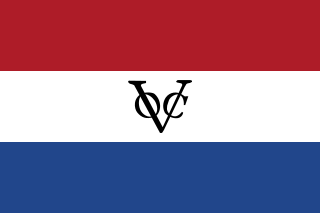
Dutch Suratte, officially Nederlandse vestiging van Suratte, was a directorate of the Dutch East India Company between 1616 and 1795, with its main factory in the city of Surat. Surat was an important trading city of the Mughal Empire on the river Tapti, and the Portuguese had been trading there since 1540. In the early 17th century, Portuguese traders were displaced by English and Dutch traders.
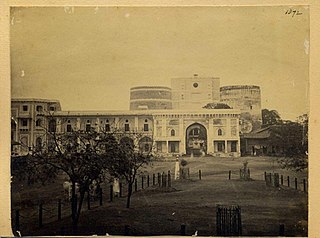
Bhadra Fort is situated in the walled city area of Ahmedabad, India. It was built by Ahmad Shah I in 1411. With its well carved royal palaces, mosques, gates and open spaces, it was renovated in 2014 by the Amdavad Municipal Corporation (AMC) and the Archaeological Survey of India (ASI) as a cultural centre for the city.

Jafarabad, or Jafrabad State, was a tributary princely state in India during the British Raj. It was located in the Kathiawar Peninsula on the Gujarat coast. The state had formerly been part of the Baroda Agency and later of the Kathiawar Agency of the Bombay Presidency.

Surat was founded in the late medieval period, and gradually became an important port in the Mughal Empire, though the earliest human presence may go as early as 300 BCE. The Maratha rulers defeated the Mughals during the Battle of Surat. Later, the Dutch ruled the area and the city became known as Dutch Suratte.

The last two Gujarat Sultans, Ahmad Shah III and Mahmud Shah III, were raised to throne when they were young so the nobles were ruling the Sultanate. The nobles divided territories between themselves but soon started fighting between themselves for supremacy. One noble invited the Mughal emperor Akbar to intervene in 1572 which resulted in the conquest of Gujarat by 1573 and Gujarat becoming the province of the Mughal Empire.

The Gujarat Subah was a province (subah) of the Mughal Empire, encompassing the Gujarat region. The region first fell under Mughal control in 1573, when the Mughal emperor Akbar defeated the Gujarat Sultanate under Muzaffar Shah III. Muzaffar tried to regain the Sultanate in 1584 but failed. Gujarat remained the Mughal province governed by the viceroys and officers appointed by the Mughal emperors from Delhi. Akbar's foster brother Mirza Aziz Kokaltash was appointed as the subahdar (viceroy) who strengthened Mughal hold over the region. The nobles of former Sultanate continued to resist and rebel during the reign of the next emperor Jahangir (1605–1627) but Kokaltash and his successor subahdars subdued them. Jehangir also permitted the British East India Company to establish factories in Surat and elsewhere in Gujarat. The next emperor Shah Jahan (1627–1658) expanded his territories in south and his subahdars made hold over Kathiawar peninsula including Nawanagar. Shah Jahan had also appointed his prince Aurangzeb, who was involved in religious disputes, prince Dara Shikoh and later prince Murad Bakhsh as subahdars. Following battle of succession, Aurangzeb (1658–1707) came to the Mughal throne and his policies resulted in revolts and discontent. During his reign, the Marathas under Shivaji raided Surat (1666) and their incursions in Gujarat started. Till then Gujarat prospered due to political stability, peace and growing international trade.
Wadhwan City railway station is a railway station serving in Surendranagar district of Gujarat State of India. It is under Bhavnagar railway division of Western Railway Zone of Indian Railways. Its station code is 'WC'. Wadhwan City railway station is 8 km (5.0 mi) from Surendranagar Junction. Passenger, Express, and Superfast trains halt here.
The Architecture of Gujarat consists of architecture in the Indian state of Gujarat.
This article is a timeline of the city Surat in Gujarat For a more comprehensive overview of Surat's history, please see History of Surat.














